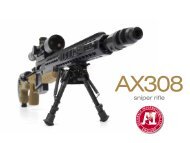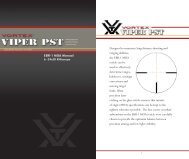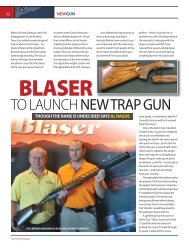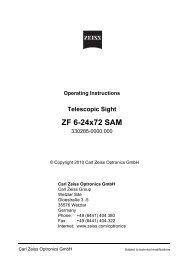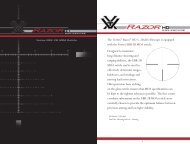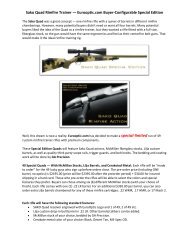90 YEARS OF RIFLE ACCURACY - Euro Optics Ltd.
90 YEARS OF RIFLE ACCURACY - Euro Optics Ltd.
90 YEARS OF RIFLE ACCURACY - Euro Optics Ltd.
Create successful ePaper yourself
Turn your PDF publications into a flip-book with our unique Google optimized e-Paper software.
SAKO-<br />
<strong>90</strong> <strong>YEARS</strong> <strong>OF</strong> <strong>RIFLE</strong><br />
<strong>ACCURACY</strong><br />
Back in 1972, gunwriting legend Jim<br />
Carmichael went to Finland to cover<br />
Sako’s 50th anniversary. Here’s a<br />
tribute to Carmichael’s long-ago trip,<br />
along with a look at what’s new there.<br />
By Eric R. Poole<br />
I<br />
wasn’t even born when it hit newsstands, but I still have a hand-medown<br />
copy of the May 1972 issue of Guns & Ammo that I picked up in California<br />
as a kid. In it, Jim Carmichael celebrated Sako’s ornate 50th Anniversary Model,<br />
based on the Finnbear action and chambered for 7mm Remington Magnum. I must<br />
have read that issue front-to-back a dozen times in the decades since.<br />
So you can probably undertand how nostalgic—and<br />
excited—I was to find myself<br />
flying to Finland to learn first-hand about<br />
one of the finest gun companies in the<br />
world. And to write about it for the same<br />
magazine Carmichael did so long ago.<br />
Footsteps in finland<br />
I arrived to Helsinki through Amsterdam.<br />
How culturally unique Finland is became<br />
immediately apparent to me. The country<br />
seems trapped in its own history. Thick<br />
reindeer hides offered for sale were stacked<br />
three feet high outside a Christmas shop<br />
inside the airport terminal, suggesting<br />
Finland was home to Santa Claus. But I<br />
couldn’t envision bringing back such grim<br />
reminders of the fate of Santa’s fourlegged<br />
helpers to the kids back home.<br />
A combination of anticipation and a<br />
sun that couldn’t set (and shined through<br />
the shade-less windows) kept me awake<br />
for most of the first night. I woke up early<br />
and explored Finland’s capital by vividly<br />
marked footpaths, observing a Russian<br />
architectural influence and old military<br />
buildings that had been converted to restaurants,<br />
shops and businesses. Small cars<br />
and a public trolley lined every street. No<br />
trash littered the corners and no bubble<br />
gum stained the concrete sidewalks. The<br />
country seemed sterile and efficient.<br />
A quiet kind of precision: For discreet target practice, the use of suppressors is<br />
encouraged throughout <strong>Euro</strong>pe. Here, the author shoots a suppressed .308 Sako<br />
TRG-22 from its bipod. He averaged 0.98-inch five-shot groups on five targets at<br />
100 meters.<br />
Shuttled by bus, I arrived later that<br />
morning to the Sako (pronounced socko,<br />
not say-ko) factory in Riihimaki, a<br />
wonderful small town located roughly 20<br />
miles north of Helsinki. Ushered from<br />
the bus, I was taken to a former ammunition<br />
manufacturing building that had<br />
been converted to a conference room and<br />
exhibit hall. Raimo Karjalainen, Sako<br />
general manager, and Pentti Louisola,<br />
senior product<br />
manager, led a<br />
group of U.S. dealers<br />
and I through a<br />
complete history of<br />
the company and a<br />
detailed review of the latest products.<br />
Of particular interest to American biggame<br />
hunters is the current development of<br />
an XL action that will afford the consumer<br />
extra-stout Safari-grade rifles chambered<br />
for elephant stoppers like the .416 Rigby<br />
and .458 Lott. To date, Sako has only been<br />
known for small, medium and large actions<br />
permitting rifles chambered in everything<br />
between .204 Ruger to the TRG-42’s farreaching<br />
.338 Lapua Magnum.<br />
As we continued our hands-on tour of<br />
the factory. I peered into every open box,<br />
inundating Raimo and Pentti with questions.<br />
Is this going to be a Model 85 bolt,<br />
I asked, holding up an L-shaped piece of<br />
cast steel? For each rough, unfinished part<br />
I held up, they’d dig out a finished version<br />
of that particular component.<br />
A blast from the<br />
past: To read Jim<br />
Carmichael’s original<br />
1972 article on<br />
his visit to Sako, go<br />
to gunsandammo.<br />
com Search Keyword:<br />
50 Years<br />
Precision spoken here<br />
I’ve visited numerous factories, and knew<br />
the quality of Sako products from my<br />
travels in the military and from evaluating<br />
many Sako rifles, so I had preconceived<br />
ideas of what to expect. But what struck<br />
me sideways was the relative absence of<br />
44 GUNS&AMMO ANNUAL 2011 ANNUAL 2011 GUNS&AMMO 45
CNC machinery. Raimo indicated more<br />
modern machinery would soon replace the<br />
old, but here inside the plant there were<br />
only a few CNC machines.<br />
For much of what was in operation, older<br />
equipment was used to forge the parts<br />
and hammer the barrels. I saw skilled<br />
craftsmen finishing each part under a<br />
critical eye—wooden trays and shelves are<br />
still used to keep components organized.<br />
It became obvious that history and tradition<br />
still plays a critical role here.<br />
After some initial hesitation, Raimo allowed<br />
an experienced assembly craftsman<br />
to teach me how to build a Sako, a Model<br />
85S as it turned out. My instructor was a<br />
legacy there—just one employee who was<br />
the son of a previous craftsman. Perhaps<br />
it was the language barrier (he was one<br />
of the few Finns I met that didn’t know<br />
English), but he already had the barrel in<br />
the action before I realized that he wasn’t<br />
going to wait for me to figure out what I<br />
was supposed to do. He effortlessly pulled<br />
The name says it all: The pistol grip caps<br />
are unique to Sako and Tikka rifles.<br />
Raimo Karjalainen,<br />
Sako<br />
general manager,<br />
was caught randomly<br />
inspecting<br />
a freshly built<br />
Sako 85 waiting<br />
to be tested for<br />
function and accuracy<br />
at the factor<br />
in Riihimaki,<br />
Finland.<br />
out and put away<br />
various metal and<br />
wood fixtures he<br />
created to make his<br />
job easier.<br />
We rolled the<br />
stainless steel action over in a vise and<br />
attached the most intricate part, an<br />
adjustable trigger group. We threw in a<br />
bolt group tested the trigger for function<br />
and gauged it for safety. I don’t remember<br />
what the gauge read since I was caught<br />
off guard when I discovered that we were<br />
working in kilos.<br />
He kept right on moving, mated a<br />
polymer stock held to the action by a<br />
forged triggerguard, and pulled down<br />
an air tool to set the action screws at the<br />
proper torque setting. He finished his<br />
part by filling a detachable box magazine<br />
of inert ammunition and running the<br />
triangular-headed bolt fore and aft while<br />
watching the rifle smoothly feed and<br />
properly extract. And just like that, “our”<br />
rifle was placed on one of many rolling<br />
carts ready to be fired in the factory’s<br />
basement range.<br />
Testing, Testing...<br />
Watching Sako rifles being proofed isn’t<br />
exactly a spectator’s sport. An inspector<br />
placed each one in a low-tech fixture<br />
drawn out like a file cabinet from the<br />
wall. He loaded and mechanically fired a<br />
proof round, then pulled out the drawer<br />
before removing and visually inspecting<br />
the bolt and fired case. He inserted<br />
another round and repeated this process<br />
four more times before the rifle moved on<br />
This Tikka T3 Sporter hadn’t been revealed<br />
to the public until the author’s visit. Blending<br />
Sako accuracy with Finland’s competitive<br />
shooting heritage, it’s an out-of-the-box .308<br />
match rifle that repeatedly punched dimesized<br />
five-shot groups at 100 meters.<br />
46 GUNS&AMMO ANNUAL 2011
Cast as asingle<br />
piece, this L-shaped<br />
component will<br />
become a bolt for a<br />
Sako 85. Sako still<br />
uses many of the<br />
same machines,<br />
wooden organizers<br />
and tools that<br />
originally built the<br />
company’s reputation.<br />
Sako’s success can be attributed to<br />
highly skilled hands-on labor and a<br />
critical eye.<br />
to accuracy testing.<br />
At the accuracy station, two young<br />
men fresh out of the country’s obligatory<br />
military service were verifying (redundantly)<br />
that each rifle was capable of<br />
printing a five-shot 1 MOA group at 100<br />
meters. Shooting each rifle on a Caldwell<br />
Lead Sled, the technicians looked through<br />
a Swarovski optic set in rings that were<br />
readily transferred to the next rifle with a<br />
nominal point of impact shift, a tribute to<br />
Sako’s Optiloc ring and base system.<br />
To the left of each shooter is a computer<br />
that reports each impact on an<br />
electronic target positioned downrange.<br />
Once accuracy is verified, the rifle is<br />
placed back on a cart for final inspection,<br />
packaging and shipping. I took a picture<br />
of Raimo handling and inspecting rifles<br />
from a cart that was similar to Carmichael’s<br />
image of Col. Elias Hyden doing<br />
the same thing more than 40 years ago.<br />
Some things never change.<br />
We left Riihimaki for regal accommodations<br />
at Vanajanlinna, a magnificent<br />
hotel and restaurant that’s considered a<br />
castle. Built in 1924, it’s a magnificent<br />
combination of Baroque and Scandinavian<br />
Renaissance architectural styles and sits<br />
along the shore of Katumajarvi Lake on<br />
500 hectares. After a customary lakeside<br />
sauna and a bottle each of Finland’s excellent<br />
beer, the group moved to dinner in<br />
the castle’s salon and closed the evening<br />
with warm cognac and a fine cigar.<br />
With the sun completely up by 3 AM,<br />
the next day couldn’t begin soon enough.<br />
After a light breakfast and a self-guided<br />
exploration of the grounds, we were off to<br />
the Finnish Hunting Museum which celebrates<br />
the country’s gun culture, starting<br />
with a vivid diorama of a shot reindeer<br />
Clearly organized in a wall of wooden shelving, Sako barrels are hammer forged,<br />
polished and finished at the factory. Calibers currently range from .204 Ruger to<br />
.375 H&H.<br />
that continues into Finland’s Olympic<br />
achievements before covering military<br />
arms (ever hear of Valmet?). The tour ends<br />
with a history of wintery challenges faced<br />
by Finnish moose and wildfowl hunters.<br />
By the time we departed for the Loppi<br />
shooting range, we were perfectly primed<br />
to pull triggers.<br />
Range Time<br />
Like most clubs, the Loppi range features<br />
areas for different types of target shooting—rimfire<br />
and centerfire at varied<br />
distances. I felt lucky to be reunited with<br />
the TRG-42 in .338 Lapua Magnum,<br />
a rifle that I’ve now shot in four countries.<br />
When I was cleared to go hot, I<br />
jumped at the open ammo can of Lapua<br />
250-grain Scenar in 10-round boxes. It<br />
was only 100 meters, but as usual, the<br />
TRG-42 punched one-hole groups.<br />
The suppressed TRG-22 offered a<br />
different experience than the thunderous<br />
TRG-42 with its three-chamber muzzle<br />
brake. The bench setup wasn’t the most<br />
ideal for getting the best accuracy out<br />
of this specialized sniper rifle, but I did<br />
manage to repeat my earlier sub-MOA<br />
groups on a few targets just by utilizing<br />
the bipod. If I could have just one Sako,<br />
the TRG-22 would be it.<br />
I’ve been a quiet fan of the Sako Quad<br />
for about six years now. I evaluated one<br />
alongside Glenn Gilbert back in 2004<br />
when the first one came in to the NRA.<br />
It’s an innovative rifle that allows the<br />
shooter to choose from four different<br />
calibers—.17 HMR, .17 Mach 2, .22 LR,<br />
and .22 WMR.<br />
I’ve heard shooters voice concerns about<br />
having to completely re-zero each time you<br />
switch calibers, and while the point-ofimpact<br />
shift is slightly different with each<br />
caliber, it turns out to be minimal once<br />
you return to the caliber you started with.<br />
The Quad Varmint has eclipsed the Quad<br />
Synthetic as my favorite in this line due<br />
to the flat-bottomed extra-wide wooden<br />
48 GUNS&AMMO ANNUAL 2011
fore-end and heavy barrel.<br />
With it, I punished a<br />
three-inch doughnut at<br />
100 meters, firing at least<br />
50 rounds through each<br />
barrel just to see how<br />
tight I could keep things.<br />
Next up was the<br />
running moose target; a<br />
real challenge. The best<br />
technique is to hold at<br />
the tip of the moose’s<br />
chin as it moves. Besides<br />
being an actual competitive<br />
event, it’s great<br />
training for moving<br />
targets, and a good test<br />
for how a rifle actually<br />
handles in the field.<br />
The Model 85 in .308<br />
worked best for me, and<br />
the weight of the .30-caliber suppressor<br />
attached to the muzzle didn’t interfere<br />
with tracking the target. I finished second<br />
in our group and just missed cleaning the<br />
course by a few points.<br />
The rifle that impressed me the most<br />
was a Sako 85 chambered in 9.3x66mm<br />
Sako. Introduced in 2002, this cartridge<br />
was originally developed for the Sako 75<br />
and, even though it has gone unnoticed<br />
in the States, it has enjoyed quite a bit of<br />
popularity in <strong>Euro</strong>pe. Registering 4,100<br />
to 4,200 ft.-lbs, muzzle energy with Sako’s<br />
286-grain Hammerhead soft point—at<br />
2560 fps—it’s comparable to the .375<br />
H&H Magnum and is a proven load for<br />
moose and bear at close range. Sako also<br />
offers a 250-grain Nosler for additional<br />
range as well as two additional 286-grain<br />
Barnes loads for enhanced penetration.<br />
My stay in Finland continued for a couple<br />
more days, which allowed me to enjoy a<br />
Hunters must qualify on a running moose target to<br />
obtain a permit. The author placed second in an impromptu<br />
match at the Loppi shooting ranges with an<br />
suppressed Sako 85 in .308.<br />
traditional dinner at the cabin of Finland’s<br />
famed Winter War hero, Marshal Mannerheim.<br />
At the Finnish Arms Museum<br />
Foundation, I got to experience exclusive<br />
access to one of the largest privately held<br />
arms collections in the world. After being<br />
overwhelmed by the contents of the main<br />
building (it makes the NRA’s National<br />
Firearms Museum look like someone’s<br />
hobby shop), I was allowed to wander<br />
outside through acres of anti-aircraft<br />
weaponry, artillery including German 88s,<br />
a semi-truck-sized naval gun, and even a<br />
pair of captured Harley Davidson military<br />
motorcycles from World War II.<br />
Even after reading Carmichel’s article<br />
as a kid, I’d never thought of Finland as a<br />
summer travel destination. But if I hadn’t<br />
made this trip, I would have missed the<br />
firearms experience of a lifetime.<br />
Not to mention the opportunity to follow<br />
in some long-ago footsteps.<br />
Helsinki Cathedral is guarded by Tsar Alexander I. He declared Finland autonomous<br />
in 1809. Sako was created in 1921, four years after Finland declared its<br />
independence.<br />
50 GUNS&AMMO ANNUAL 2011



